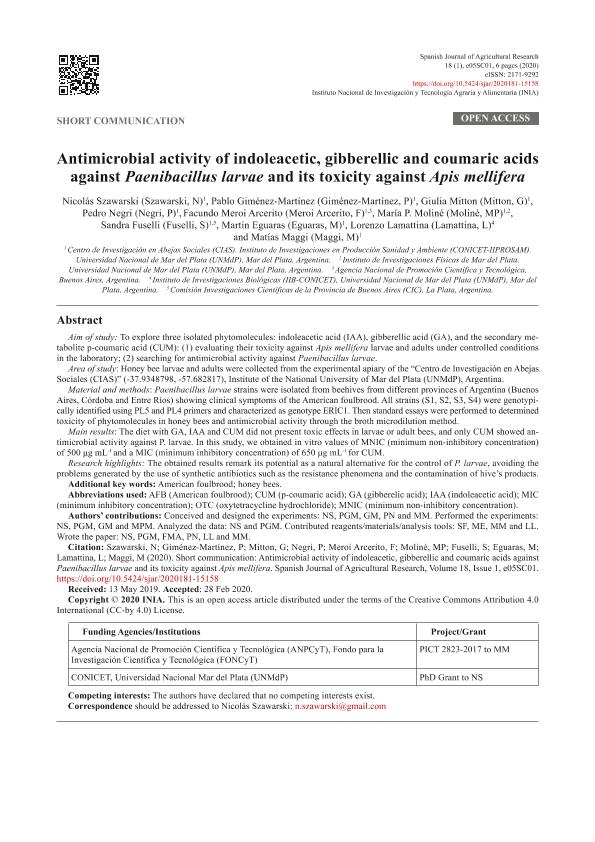Artículo
Antimicrobial activity of indoleacetic, gibberellic and coumaric acids against paenibacillus larvae and its toxicity against apis mellifera
Szawarski, Nicolás ; Giménez Martínez, Pablo Darian
; Giménez Martínez, Pablo Darian ; Mitton, Giulia Angelica
; Mitton, Giulia Angelica ; Negri, Pedro
; Negri, Pedro ; Meroi Arcerito, Facundo René
; Meroi Arcerito, Facundo René ; Moliné, Maria de la Paz
; Moliné, Maria de la Paz ; Fuselli, Sandra; Eguaras, Martín; Lamattina, Lorenzo
; Fuselli, Sandra; Eguaras, Martín; Lamattina, Lorenzo ; Maggi, Matías Daniel
; Maggi, Matías Daniel
 ; Giménez Martínez, Pablo Darian
; Giménez Martínez, Pablo Darian ; Mitton, Giulia Angelica
; Mitton, Giulia Angelica ; Negri, Pedro
; Negri, Pedro ; Meroi Arcerito, Facundo René
; Meroi Arcerito, Facundo René ; Moliné, Maria de la Paz
; Moliné, Maria de la Paz ; Fuselli, Sandra; Eguaras, Martín; Lamattina, Lorenzo
; Fuselli, Sandra; Eguaras, Martín; Lamattina, Lorenzo ; Maggi, Matías Daniel
; Maggi, Matías Daniel
Fecha de publicación:
03/2020
Editorial:
Spanish National Institute for Agriculture and Food Research and Technology
Revista:
Spanish Journal Of Agricultural Research
ISSN:
1695-971X
e-ISSN:
2171-9292
Idioma:
Inglés
Tipo de recurso:
Artículo publicado
Clasificación temática:
Resumen
Aim of study: To explore three isolated phytomolecules: indoleacetic acid (IAA), gibberellic acid (GA), and the secondary me-tabolite p-coumaric acid (CUM): (1) evaluating their toxicity against Apis mellifera larvae and adults under controlled conditions in the laboratory; (2) searching for antimicrobial activity against Paenibacillus larvae. Area of study: Honey bee larvae and adults were collected from the experimental apiary of the “Centro de Investigación en Abejas Sociales (CIAS)” (-37.9348798,-57.682817), Institute of the National University of Mar del Plata (UNMdP), Argentina. Material and methods: Paenibacillus larvae strains were isolated from beehives from different provinces of Argentina (Buenos Aires, Córdoba and Entre Ríos) showing clinical symptoms of the American foulbrood. All strains (S1, S2, S3, S4) were genotypi-cally identified using PL5 and PL4 primers and characterized as genotype ERIC1. Then standard essays were performed to determined toxicity of phytomolecules in honey bees and antimicrobial activity through the broth microdilution method. Main results: The diet with GA, IAA and CUM did not present toxic effects in larvae or adult bees, and only CUM showed an-timicrobial activity against P. larvae. In this study, we obtained in vitro values of MNIC (minimum non-inhibitory concentration) of 500 μg mL-1 and a MIC (minimum inhibitory concentration) of 650 μg mL-1 for CUM. Research highlights: The obtained results remark its potential as a natural alternative for the control of P. larvae, avoiding the problems generated by the use of synthetic antibiotics such as the resistance phenomena and the contamination of hive’s products.
Archivos asociados
Licencia
Identificadores
Colecciones
Articulos(CCT - MAR DEL PLATA)
Articulos de CTRO.CIENTIFICO TECNOL.CONICET - MAR DEL PLATA
Articulos de CTRO.CIENTIFICO TECNOL.CONICET - MAR DEL PLATA
Articulos(IFIMAR)
Articulos de INST.DE INVESTIGACIONES FISICAS DE MAR DEL PLATA
Articulos de INST.DE INVESTIGACIONES FISICAS DE MAR DEL PLATA
Citación
Szawarski, Nicolás; Giménez Martínez, Pablo Darian; Mitton, Giulia Angelica; Negri, Pedro; Meroi Arcerito, Facundo René; et al.; Antimicrobial activity of indoleacetic, gibberellic and coumaric acids against paenibacillus larvae and its toxicity against apis mellifera; Spanish National Institute for Agriculture and Food Research and Technology; Spanish Journal Of Agricultural Research; 18; 1; 3-2020; 1-6
Compartir
Altmétricas



